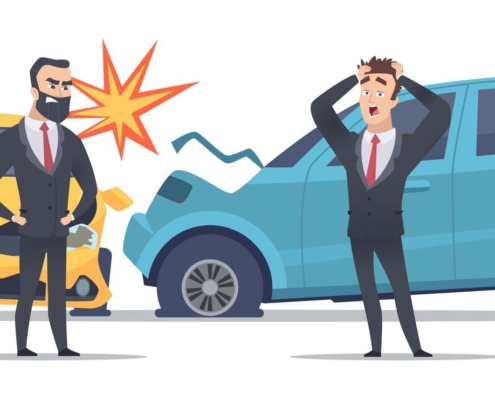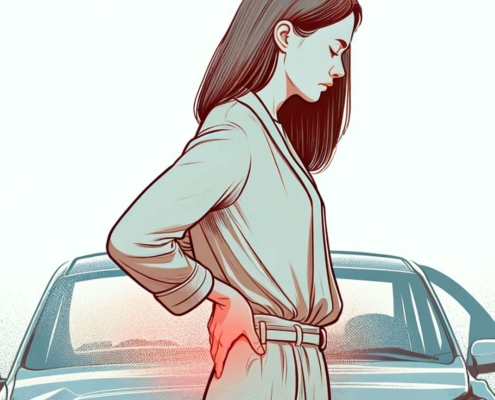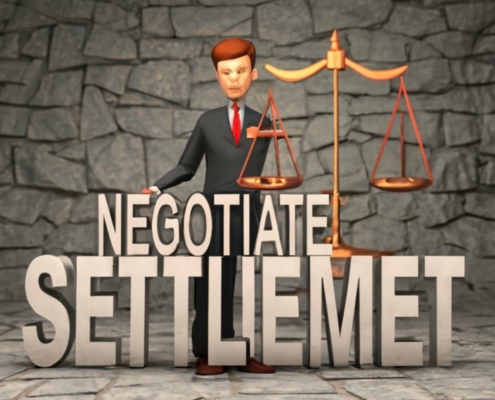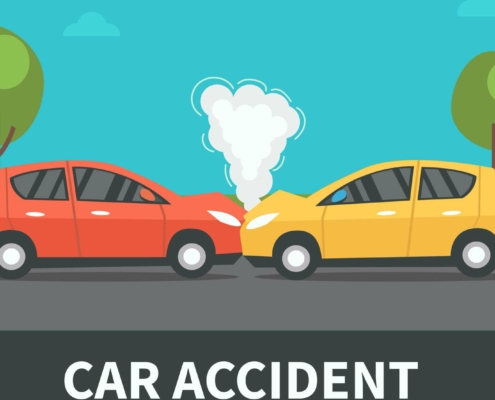What To Do After an Accident In A Leased Car
After a car accident in a leased car, you must notify the leasing company and the auto insurance company.
By Brad Nakase, Attorney
Email | Call (888) 600-8654
What happens when you get into an accident in a leased car?
Following a leased car accident, notify the the leasing company and file a claim with your insurance company. In recent years, leasing has emerged as a popular choice for individuals seeking a more flexible and cost-effective approach to car ownership. With lower monthly payments, the allure of driving newer models, and the peace of mind that comes with warranty coverage, leasing has become an attractive option for many drivers. However, amidst the excitement of leasing a car, it’s crucial to be prepared for unforeseen circumstances that can arise, such as getting into an accident. Understanding the implications and navigating the aftermath of an accident in a leased vehicle require careful consideration and knowledge.
In this article, our Los Angeles car accident attorney will delve into the specific challenges and essential steps to take when faced with such a situation, providing valuable insights to help you navigate the complexities of handling an accident in a leased car:
What are the first steps after a leased car accident?
After being involved in a leased car accident, it is important to take immediate action to ensure your safety, as well as that of the other motorist, and gather the necessary information.
- Ensure Safety and Seek Medical Attention: The well-being of all individuals involved in the accident is the top priority. If anyone is injured or requires medical attention, call emergency services by dialing 911 immediately. Promptly seeking medical help is essential, even if injuries appear minor or non-existent initially, as some injuries may manifest later.
- Contact Emergency Services: Even if there are no immediate injuries, it is important to call 911 to report the accident. Inform them about the location and request police assistance to have an official accident report filed. This report will be crucial for insurance claims and legal purposes.
- Exchange Information: While at the accident scene, gather essential information from all parties involved. Exchange the following details with the other drivers:
-
- Full name and contact information
- Insurance company and policy number
- Vehicle make, model, and license plate number
- Driver’s license number
While you should be polite and cooperative during this process, refrain from admitting fault or discussing liability. Stick to factual details and avoid engaging in arguments or discussions about who is to blame.
- Document the Scene: If it is safe to do so, document the accident scene by taking photographs or videos. Capture the position of the vehicles involved, the damage sustained, and any relevant road conditions or traffic signals. This evidence can be valuable during insurance claims or legal proceedings.
- Gather Witness Information: If there were any witnesses to the accident, try to obtain their names and contact details. Their statements may provide valuable additional perspectives or support your case if liability becomes a concern.
Remember, the specific steps to take may vary depending on the severity of the accident, local laws, and your insurance policy requirements. It is recommended that you consult your lease agreement and insurance provider to ensure you fulfill all necessary obligations and follow any specific guidelines related to accidents in a leased vehicle.
Once you have addressed immediate concerns and ensured everyone’s safety, the next crucial step is to notify your insurance company and report the accident. You should also contact a personal injury attorney to assist you with your claim and injury. Promptly informing your insurance provider will initiate the claims process and provide you with guidance on how to proceed.
Calling 911 after an accident for medical help
When involved in an accident, calling 911 to request medical attention is of the utmost importance. The well-being of all individuals involved takes precedence over any other concerns. Immediately dialing 911 allows you to summon emergency medical services to the scene. Even if injuries seem minor or not immediately apparent, it is crucial to seek medical attention promptly. Some injuries may not manifest immediately, and a qualified medical professional can assess and address any potential health issues. By alerting emergency services, you enable them to dispatch an ambulance and provide necessary aid, ensuring that any injured parties receive proper medical care as quickly as possible. The swift response of trained medical personnel can potentially make a significant difference in minimizing the impact of injuries and providing timely treatment. Remember, the priority is to prioritize the health and well-being of all individuals involved in the accident.
Calling 911 after an accident for police assistance
In the event of a car accident, it is essential to call 911 to request police assistance. Contacting the police serves multiple purposes and is crucial for several reasons. First and foremost, it ensures that an official accident report is generated. The police officers who respond to the scene will document the details of the accident, including the location, parties involved, and any witnesses present. This report acts as an objective record of the incident and can be vital when filing insurance claims and dealing with legal matters. The police report helps establish an unbiased account of the accident, which can be invaluable in determining fault and liability.
Further, having law enforcement present can help maintain order and ensure the safety of all individuals involved, especially in stressful situations where emotions may be running high. The police can also assist in managing traffic, securing the accident scene, and providing guidance on the necessary steps to follow. Ultimately, contacting 911 for police involvement contributes to a thorough documentation of the accident and promotes a smooth process for handling the aftermath.
Exchanging information with another driver
Exchanging information with the other driver involved in an accident is a critical step in the immediate aftermath. It helps facilitate the claims process and ensures that all parties have the necessary details for insurance purposes and potential legal proceedings. When exchanging information, it is important to remain calm and cooperative. Start by obtaining the other driver’s full name, contact information, and insurance company details, including the policy number. Additionally, exchange details about the vehicles involved, including make, model, and license plate numbers. It is also crucial to exchange driver’s license numbers to establish identity.
While engaging in this process, it is essential to focus on factual information and avoid engaging in discussions about fault or liability. It is not your role to determine fault at the scene, and admitting fault or accepting blame can have implications on insurance claims. Stick to gathering the necessary information while being respectful and professional. This exchange of information lays the foundation for communication between insurance companies and helps ensure a smooth and accurate processing of claims.
Investigating the crash scene after an accident
Investigating the crash scene after an accident is crucial for gathering relevant information that can support insurance claims and potential legal proceedings. To effectively investigate the scene, there are several key pieces of information you should aim to collect. Start by documenting the position of the vehicles involved in the accident. You might also take photographs or videos that clearly show the vehicles’ locations, including any skid marks or debris on the road. Be sure to capture the damage sustained by each vehicle from multiple angles. It is also essential to document any relevant road conditions, such as weather conditions, the presence of traffic signs or signals, and the state of the road surface. These details can help establish factors that may have contributed to the accident.
Also, if there are witnesses present, gather their names and contact information. Their statements and testimonies can provide valuable additional perspectives. Be sure to ask witnesses for their account of the accident, any actions they observed, or any conversations they overheard. Gathering this information promptly and accurately can assist insurance companies and legal professionals in determining fault and liability and help you build a stronger case if needed.
Reporting an accident to auto insurance
To report an accident in a leased car to your auto insurance company, you can follow these steps:
- Contact Your Insurance Company: As soon as possible after the accident, reach out to your auto insurance company. Refer to your insurance policy or insurance card for the contact information. Most insurance companies have dedicated helpline numbers or claims departments available 24/7. Inform them about the accident and provide relevant details.
- Provide Accurate Information: Be prepared to provide specific information about the accident, including the date, time, and location of the incident. Describe what happened to the best of your ability and provide details about the parties involved, such as the other driver’s information and any witnesses present. You should provide a clear and concise account of the accident without admitting fault or speculating on liability.
- Provide Insurance and Leasing Information: When reporting the accident, provide your insurance company with the necessary details about your leased vehicle. This includes the lease agreement information, the leasing company’s name and contact information, and any specific requirements related to accidents mentioned in your lease agreement. This information helps the insurance company coordinate with the leasing company as necessary.
- Cooperate with the Claims Process: Your insurance company will guide you through the claims process. They may assign a claims adjuster to investigate the accident further and assess the damages. Follow their instructions and cooperate fully, providing any additional documentation or information they may request. This can include the police report, photographs of the accident scene, or medical records if injuries were sustained.
- Follow Up and Keep Documentation: Keep track of all correspondence and documentation related to the accident and insurance claim. This includes claim numbers, names of insurance representatives you speak with, and copies of any written communication. Documenting the details will help you stay organized and provide reference points if any issues or disputes arise during the claims process.
Note that the specific procedures may vary depending on your insurance provider and the terms of your policy. It is important to review your insurance policy or contact your insurance company directly for precise instructions on how to report an accident in a leased car and navigate the claims process effectively.
Reporting an accident for a lease car
To report an accident in a leased car to the dealership or leasing company, you can follow these steps:
- Review Your Lease Agreement: Before contacting the dealership, review your lease agreement to understand the specific requirements and procedures for reporting accidents. The agreement may outline the necessary steps, contact information, and any specific forms or documentation that need to be submitted.
- Contact the Dealership: Reach out to the dealership where you leased the car as soon as possible to report the accident. Obtain the contact information from your lease agreement, the dealership’s website, or by contacting their main phone line. Inform them about the accident and provide relevant details such as the date, time, and location of the incident.
- Follow Dealership’s Instructions: The dealership will guide you through their specific reporting process. They may ask for documentation such as an accident report, police report, or insurance claim details. Follow their instructions carefully and provide the requested information promptly. This helps ensure that the dealership is aware of the accident and can proceed with any necessary repairs or assessments.
- Coordinate with Insurance Company: Notify your auto insurance company about the accident and initiate the claims process as discussed earlier. In some cases, the dealership may need to work directly with your insurance company for repairs or settlement. Make sure to share the insurance information with the dealership if requested, so they can coordinate accordingly.
- Document and Keep Records: Throughout the process of reporting the accident to the dealership, maintain thorough documentation of all interactions, including dates, times, and names of dealership representatives you speak with. Keep copies of any written communication or forms provided by the dealership. This documentation will be useful for reference and may be required if there are any disputes or issues down the line.
It is important to note that the specific reporting process may vary depending on the leasing company and the terms of your lease agreement. Some dealerships have dedicated departments or personnel to handle accident reports, while others may require you to contact a general customer service line. Review your lease agreement and contact the dealership directly for precise instructions on reporting an accident in a leased car to ensure compliance with their specific protocols.
How do you repair a leased vehicle after an accident?
When seeking repairs for a leased vehicle after an accident, there are a few key steps to follow. First, contact your auto insurance company and report the accident. They will guide you through the claims process and determine the extent of coverage based on your policy. The insurance company may require you to provide documentation such as the police report, accident photos, and any witness statements. Depending on the terms of your lease agreement, the insurance company may work directly with the dealership or leasing company to arrange repairs. The dealership may have preferred repair facilities or authorized service centers where the vehicle can be taken for repairs. It is important to follow any specific instructions provided by the insurance company and the leasing company to ensure that repairs are carried out according to the terms of the lease agreement.
Determining liability for claims in an accident involving a leased vehicle is typically handled by insurance adjusters who assess the details of the accident and review applicable laws and policies. Insurance companies consider factors such as police reports, witness statements, accident scene investigation, and any available evidence to determine liability. It is their responsibility to assign fault based on the information available. However, the specifics of liability determination may vary depending on the jurisdiction and insurance policies involved. In some cases, liability may be shared between multiple parties involved in the accident. If liability is disputed or there are disagreements regarding fault, legal assistance may be necessary to resolve the matter. Crucially, you should maintain open communication with your insurance company and provide any requested information to aid in their liability determination process.
How do you file a claim against another driver after an accident?
Filing a claim against another driver after an accident typically involves the following process:
- Gather Information: Collect all relevant information related to the accident, including the other driver’s contact details, insurance information, and vehicle details. If there were any witnesses, obtain their names and contact information as well. Document the scene of the accident, take photographs of the damage sustained, and make note of any visible injuries.
- Notify Your Insurance Company: Contact your auto insurance company and inform them about the accident. Provide them with all the details you have gathered, including the information about the other driver. Your insurance company will guide you through the claims process and may advise you on the next steps to take.
- Contact the Other Driver’s Insurance Company: Obtain the contact information for the other driver’s insurance company. Reach out to them to initiate the claim against the other driver. Provide them with the necessary details of the accident, including the date, time, location, and a description of what occurred.
- Cooperate with the Claims Process: Once you have filed the claim with the other driver’s insurance company, cooperate fully with their claims adjuster. The adjuster may request additional information, such as the police report, photographs, or medical records if injuries were sustained. Respond promptly and provide all requested documentation to support your claim.
- Seek Legal Advice if Necessary: If there are complexities or disputes regarding liability, the extent of damages, or if the other driver’s insurance company is not cooperating, it may be advisable to seek legal advice. An attorney experienced in personal injury or car accident cases can provide guidance and advocate on your behalf.
Throughout the process, maintain detailed records of all communication, including dates, times, and names of individuals you speak with. Keep copies of all correspondence, documents, and bills related to medical treatment or vehicle repairs. This documentation will help support your claim and provide evidence if the case requires further legal action.
How do you file a claim against your own insurance after an accident?
Filing a claim against your own insurance coverage after getting into an accident in a leased car usually involves the following steps:
- Review Your Insurance Policy: Familiarize yourself with the terms and coverage details of your auto insurance policy. Understand the types of coverage you have, such as liability, collision, comprehensive, and personal injury protection. Take note of any specific provisions related to leased vehicles.
- Contact Your Insurance Company: Notify your own insurance company as soon as possible after the accident. Provide them with accurate and detailed information about the accident, including the date, time, location, and a description of what occurred. Be prepared to provide the insurance company with the relevant details of the leased vehicle, such as the lease agreement information, leasing company details, and any specific requirements outlined in your lease agreement.
- Provide Documentation: Your insurance company may request documentation to support your claim. This can include the police report, accident scene photographs, medical records if injuries were sustained, and any other relevant information they require. Cooperate fully with their requests and provide the necessary documentation promptly to facilitate the claims process.
- Determine the Coverage: Depending on the specific coverage you have in your insurance policy, your insurance company will assess the damages and determine the coverage that applies. For example, if you have collision coverage, it may help cover the damages to your leased vehicle. If you have personal injury protection, it may help with medical expenses related to injuries. Your insurance company can guide you through the specific coverage details and limits.
- Pay the Deductible: If your insurance policy has a deductible, you will be responsible for paying that amount before your insurance coverage applies. The deductible is usually stated in your policy, and the insurance company will inform you of the deductible amount that needs to be paid.
- Coordinate with the Leasing Company: If repairs are necessary, your insurance company may work directly with the leasing company to handle the repair process. The insurance company will follow the necessary procedures to ensure repairs are done according to the terms of your lease agreement.
Remember to keep detailed records of all communication with your insurance company, including the names of representatives you speak with, dates, times, and any relevant information exchanged. This documentation will be useful if there are any disputes or issues during the claims process.
How do you coordinate car repairs with a leasing company?
When coordinating repairs with your car leasing company after an accident, it is important to follow these steps:
- Contact the Leasing Company: Notify your car leasing company about the accident as soon as possible. Refer to your lease agreement or contact their customer service department to obtain the appropriate contact information. Inform them about the accident, provide any relevant details, and inquire about their specific requirements and procedures for handling repairs.
- Follow Their Instructions: The leasing company will guide you through their process for coordinating repairs. They may have preferred repair facilities or authorized service centers where the repairs need to be conducted. Follow their instructions carefully and inquire about any specific forms or documentation they require.
- Coordinate with Your Insurance Company: Notify your car insurance company about the accident and initiate the claims process. Inform them that the vehicle is leased and provide them with the leasing company’s information as requested. Your insurance company will work in coordination with the leasing company to ensure that repairs are carried out according to their requirements.
- Submit Required Documentation: The leasing company may request certain documentation related to the accident and repairs. This can include the insurance claim details, copies of repair estimates or invoices, photographs of the damage, and any other relevant information. Submit these documents promptly to the leasing company to facilitate the repair process and any potential reimbursement.
- Communicate and Follow Up: You should maintain open communication with the leasing company throughout the repair process. Inquire about the estimated timeline for repairs and any additional steps you need to take. Be sure to keep a record of all communication, including dates, times, and names of individuals you speak with, as well as any written correspondence.
By coordinating repairs with your car leasing company, you ensure that the repairs are carried out in accordance with their specific requirements and guidelines. This helps maintain compliance with the terms of your lease agreement and ensures that the ca is restored to its pre-accident condition. It is important to follow the leasing company’s instructions, maintain communication with both the leasing company and your insurance company, and provide the necessary documentation to facilitate a smooth repair process.
Have a quick question? We answered nearly 2000 FAQs.
See all blogs: Business | Corporate | Employment Law
Most recent blogs:
Contact our attorney.




























